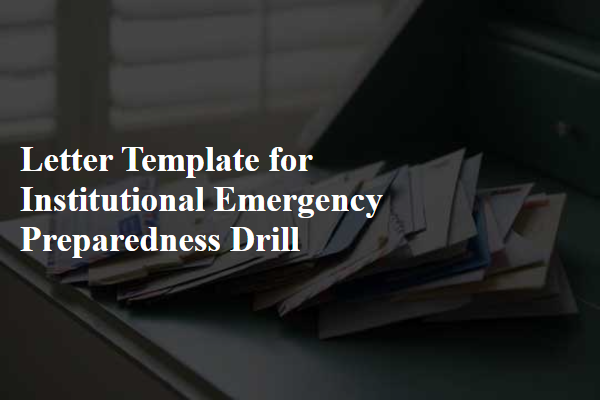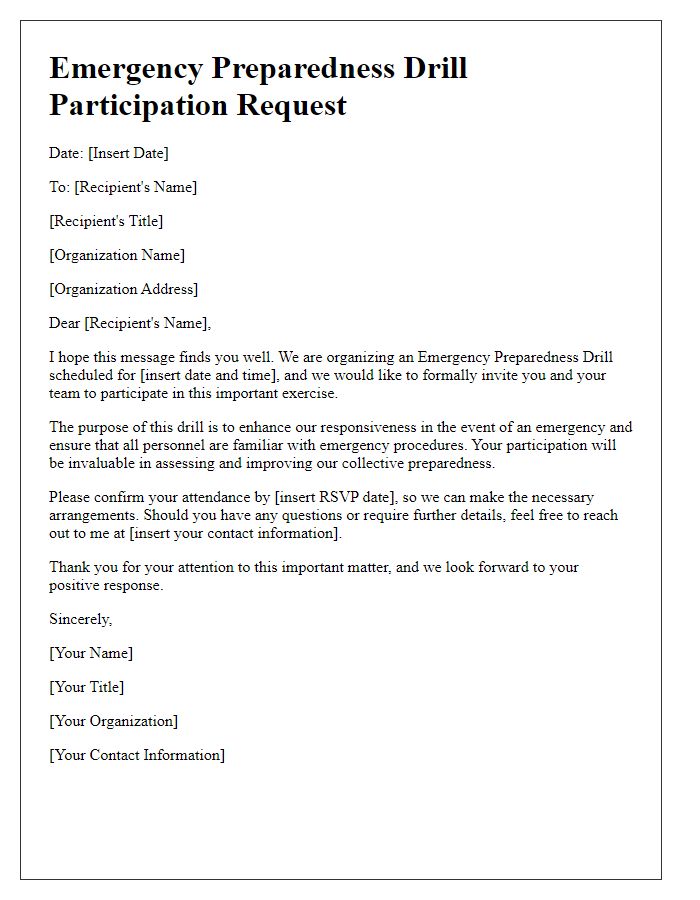In today's unpredictable world, being prepared for emergencies is more crucial than ever, especially for institutions that serve the public. Emergency preparedness drills not only enhance our readiness but also foster a culture of safety and awareness among staff and students. By simulating various scenarios, we can identify potential weaknesses and strengthen our response strategies. Ready to learn how your institution can effectively implement these vital drills? Keep reading!

Objective and Purpose
The emergency preparedness drill aims to enhance institutional resilience through realistic simulation of crisis scenarios, ensuring staff and personnel are well-informed and trained in emergency protocols. Objectives include evaluating current emergency plans, assessing response times (target of under five minutes), and improving communication procedures among emergency response teams. The drill will focus on key areas such as evacuation procedures (established routes), incident response (first aid, fire safety), and coordination with local authorities (police, fire department). All participants must engage in realistic role-playing to identify potential gaps in training and execute a comprehensive debriefing post-drill to gather insights for future improvements.
Schedule and Timeline
The Institutional Emergency Preparedness Drill will take place on March 15, 2024, at 10:00 AM, across multiple facilities including the Main Auditorium, Gymnasium, and Classroom Building. This drill is designed to enhance the response capabilities of participants during a simulated emergency situation. The timeline includes a briefing session at 9:30 AM, where all staff and volunteers will receive instructions and objectives. At 10:15 AM, participants will initiate the emergency response procedures, followed by a debriefing at 11:30 AM to review actions taken and areas for improvement. The entire exercise aims to ensure compliance with safety regulations and improve coordination among different departments within the institution. Key stakeholders include local emergency services, campus security, and designated safety officers.
Roles and Responsibilities
Emergency preparedness drills are essential for institutional safety, ensuring staff understand their roles and responsibilities during a crisis. Key participants include the Incident Commander, who leads the response efforts, and the Safety Officer, responsible for monitoring safety conditions. Additionally, team members perform specific functions, such as communication liaison, coordinating with external emergency services like local fire departments, and first responders such as paramedics. Support staff manage logistics, ensuring supplies like medical kits and food are accessible. Each drill scenario, whether a fire evacuation, earthquake response, or active shooter situation, should simulate real-life conditions, testing the institution's emergency plans in locations such as classrooms, offices, or outdoor spaces. Regular drills increase awareness, enhancing response times and minimizing chaos in actual emergencies.
Communication Channels
Effective communication channels are crucial during institutional emergency preparedness drills, ensuring timely information dissemination among staff and stakeholders. Various methods, including emails, text alerts, and designated loudspeakers, play significant roles in relaying important announcements, such as evacuation procedures or shelter-in-place directives. Utilizing platforms like social media can enhance real-time updates, fostering transparency. Furthermore, regular communication training sessions (typically occurring quarterly) equip employees with essential skills to utilize these channels effectively. Clear communication protocols established prior to drills (in alignment with the National Incident Management Assistance Team guidelines) can significantly improve response times and overall safety during actual emergencies.
Evaluation and Feedback Process
The institutional emergency preparedness drill serves as a crucial exercise for evaluating response effectiveness and identifying improvements. Scheduled across multiple locations, such as community centers and educational institutions, this drill focuses on simulating various emergency scenarios, including fire evacuations and active shooter situations. Participants, typically numbering in the hundreds, are assessed on their adherence to protocols and timely communication. Observers from the emergency services, such as local fire departments and law enforcement, provide critical feedback on efficiency and areas needing enhancement. Post-drill evaluations encompass debrief sessions, where actionable insights are gathered, ensuring continuous improvement in the institution's emergency response plans. Additionally, input from participants, encompassing diverse roles such as staff, students, and first responders, plays a vital part in this iterative process, ultimately bolstering the institution's resilience against real-life emergencies.
Letter Template For Institutional Emergency Preparedness Drill Samples
Letter template of institutional emergency preparedness drill notification

Letter template of institutional safety procedures for drill participants












Comments